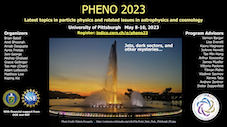Speaker
Description
Ultralight dark-photon dark matter coupled to the Standard Model (through e.g. $B$ or $B−L$ charges) would supply a new force that oscillates with a frequency set by the dark photon mass. Such forces result in fluctuations in the separation between inertial test masses, a physical quantity tracked in many gravitational-wave (GW) detectors. A recent GW detection proposal based on monitoring the separation of certain asteroids in the inner Solar System would be sensitive to frequencies in the experimentally-challenging μHz band. In this talk, I discuss how that proposal would also enable access to new parameter space for dark-photon dark matter, well beyond current best limits.
